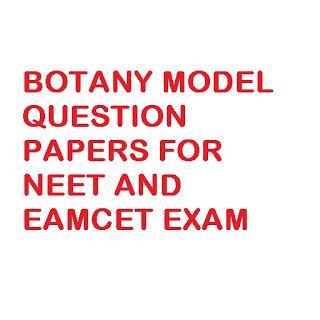BOTANY MODEL QUESTIONS FOR NEET AND EAMCET EXAM
1. Haploid plant body is a common feature of which of the following groups?
a. Bryophytes and pteridophytes
b. Fungi , algae and pteridophytes
c. Bryophytes and gymnosperms
d. Fungi, algae and bryophytes
ans. d
2. Parthenogenesis refers to
a. Development of embryo from unfertilized diploid female gamate
b. Development of embryo from diploid zygote
c. Development of fruit without fertilization
d. Development of seed without fertilization
ans. a
3. The substance responsible for the preservation of pollen in fossil plants is
a. Peptidoglycon
b. Sporopollenin
c. Pectin
d. Murein
ans. b
4. Michaelia and Annona show gynoecium which is
a. Monicarpellary
b. Multicarpellary syncarpous
c. Multicarpellary apocarpous
d. Multicarpellary sub-apocarpus
ans. c
5.The angiospermic family in which we see180 degrees curvature of the ovule
a. Fabaceae
b. Asteraceae
c. Cucurbitaceae
d. Cactaceae
ans. b
6. Anthocephalus kadamba and kigella are pollinated by
a. Birds
b. Bees
c. Bats
d. Butterflies
ans. c
7. Which of the following outbreeding devices is shown by datura and Solanum to prevent self-pollination?
a. Protandy
b. Protogyny
c. Dicliny
d. Herkogamy
ans. b
8. Scutellum is found in the family
a. solanaceae
b. poaceae
c. Asteraceae
d. Fabaceae
ans. b
9. The angiospermic family known for its microscopic seeds producced in large numbers is
a. Poaceae
b. liliaceae
c. Asteraceae
d. Fabacear
ans. c
10. Which element required for activity of both nitrogenase and nitrate reductase enzymes is
a. Zinc
b. Magnesium
c. Molybdenum
d. Manganese
ans. c
a. Bryophytes and pteridophytes
b. Fungi , algae and pteridophytes
c. Bryophytes and gymnosperms
d. Fungi, algae and bryophytes
ans. d
2. Parthenogenesis refers to
a. Development of embryo from unfertilized diploid female gamate
b. Development of embryo from diploid zygote
c. Development of fruit without fertilization
d. Development of seed without fertilization
ans. a
3. The substance responsible for the preservation of pollen in fossil plants is
a. Peptidoglycon
b. Sporopollenin
c. Pectin
d. Murein
ans. b
4. Michaelia and Annona show gynoecium which is
a. Monicarpellary
b. Multicarpellary syncarpous
c. Multicarpellary apocarpous
d. Multicarpellary sub-apocarpus
ans. c
5.The angiospermic family in which we see180 degrees curvature of the ovule
a. Fabaceae
b. Asteraceae
c. Cucurbitaceae
d. Cactaceae
ans. b
6. Anthocephalus kadamba and kigella are pollinated by
a. Birds
b. Bees
c. Bats
d. Butterflies
ans. c
7. Which of the following outbreeding devices is shown by datura and Solanum to prevent self-pollination?
a. Protandy
b. Protogyny
c. Dicliny
d. Herkogamy
ans. b
8. Scutellum is found in the family
a. solanaceae
b. poaceae
c. Asteraceae
d. Fabaceae
ans. b
9. The angiospermic family known for its microscopic seeds producced in large numbers is
a. Poaceae
b. liliaceae
c. Asteraceae
d. Fabacear
ans. c
10. Which element required for activity of both nitrogenase and nitrate reductase enzymes is
a. Zinc
b. Magnesium
c. Molybdenum
d. Manganese
ans. c
